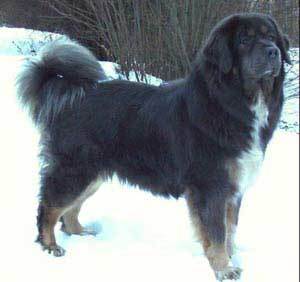“This post contains affiliate links, and I will be compensated if you make a purchase after clicking on my links.”
Description
The Tibetan Mastiff, also known as Do-Khyi, is a breed of massive, giant dog that originated in Tibet. It belongs to the working breed family which is remarkable for their exceptional skills in carrying out jobs such as guarding property, sled-pulling, and or water-rescuing. Tibetan Mastiffs have been bred to become guardians of homes, herds, and flocks. Their immense double coat is thick and has a heavy mane that surrounds the neck. Coat colors usually include brown, black, blue-gray; all with or with no tan, golden, or white markings.
Height and Weight
Both the male and female members of the Tibetan Mastiff breed normally stand a height of 25 to 28 in at the withers, and weigh 140 to 170 lbs.
Temperament

Tibetan Mastiffs, in general, are calm, even-tempered, and thoughtful dogs. They are extremely loyal, and love to please their master. The breed is loving especially with children, though may become aloof and suspicious with strangers if not socialized properly. Tibetan Mastiffs are also known for being courageous and fearless. In fact, the breed is admired for being an outstanding flock guardian. They are seen to be ferocious against leopards, wolves, or any other prey that attempts to approach their guarded flocks. Tibetan Mastiffs are rather easy when it comes to housebreak, though may mature much later in life as compared to the average breed. To keep them from becoming willful, stubborn, over-protective, and territorial, handlers should be firm, self-assured, and consistent in their leadership approach.
Grooming
Tibetan Mastiff pets need to be brushed on a regular basis. They do not shed, but they tend to blow their coat off once a year at the time when all of its dead hairs are shed at once.During this period, handlers have to step up their coat care efforts by brushing and combing the breed each day.
Health Concerns
Members of the Tibetan Mastiff breed are generally healthy. They have an average life expectancy of 10 to 14 years. Nonetheless, they are still susceptible to a few health issues such as entropion, ectropion, hypothyroidism, allergies, autoimmune disorders, epilepsy, eye problems, cardiac diseases, hip and elbow dysplasia, and demyelinative neuropathy.
Best Environment
Tibetan Mastiff pets thrive best in an environment that gives them access to a secure, spacious yard for exercise. They can adjust to apartment living provided that they get to receive adequate exercise. The breed is rarely very active indoors. Taking them out for daily walks would be highly recommended to keep them happy.












